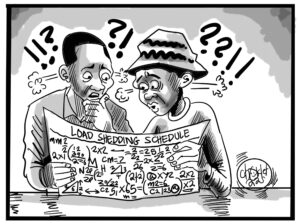National Democratic Congress leader Chishimba Kambwili says Zambians must protest government’s plans to give Konkola Copper Mines (KCM) to a Chinese investor.
And Kambwili says there is no transparency in the KCM liquidation process.
In an interview, Kambwili observed that all indications showed that government wanted a Chinese investor to take over KCM but warned against that, saying Chinese were not good at adhering to labour laws or engaging in corporate social responsibility activities.
“I have spoken over that time and again and thank God that Mwila went to Chingola, he was on Radio Kokoliko and he said ‘we are not giving the mine to the Chinese. I hope he can live by his words. All indicators are pointing to the fact that they want to give the mine to the Chinese, I have warned them that Chinese running the mines is as good as not having an investor. One, they don’t give business to Zambian companies, everything is done by fellow Chinese, they pay low salaries, they don’t follow labour laws and government cannot do anything about the Chinese, they have failed. So, look at the way Chambishi is, look at the way Luanshya is, that’s the way you want Chingola to be? Posterity will judge them very harshly and I can only hope that is not the direction they are taking,” Kambwili said.
“The poverty levels will go up, the economy of Chingola will definitely be in shambles, there will be a lot of suffering because usually what they do, they employ a few Zambians and bring a lot of Chinese who are either prisoners or cheap labour so that they cut off costs and we don’t even understand who gives them work permits. So such is the behavior of the PF government under Lungu and there us very little that we can do, we can only advise but insoni ebuntu and I have said, Zambians are scared of demonstrations. Because if the government wants to give the mine to the Chinese, it is better to go on the streets and demonstrate. It is better to go on the street and demonstrate, all over Zambia, to say that we cannot accept this but as usual, there’s a lot of fear among the Zambians. When they just see police uniforms, they want to run away but I want to urge the people of Chingola and the Mine Workers’ Union of Zambia, reject Chinese, you accept them at your own peril.”
And Kambwili said the whole KCM liquidation process lacked transparency.
“There is no transparency, the moment they appointed that Milingo Lungu, who is close to State House, who is a PF cadre, there is no transparency whatsoever, the whole thing has been going to favor those in authority to get some good kickbacks,” said Kambwili.




















One Response
Whether it is the Chinese or some other investor poverty will still be in Zambia because the bottom line is income from the mines particularly the foreign currency the mines generate. By the early 1990s, the time when ZCCM and other parastatals were privatized, the Bank of Zambia directive towards ownership of foreign currency was “One hundred (100) percent foreign currency retention from exports,” which meant the newly privatized mines could still continue to own all the forex like ZCCM, but with no obligation to surrender the foreign currency to the State.
The mines now could pay for their own investment loans as they had direct and unlimited access to all of Zambia’s foreign currency and not having the same foreign currency pay for Zambia’s national debts or interest on loans.
The reason advanced for such a directive by the Movement for Multiparty and Democracy (MMD) was that it was meant to be an incentive to attract foreign investment, which sadly undermined Zambia’s financial money markets and the Kwacha.
Thus the foreign currency privilege ZCCM had had, had been upon privatization transferred to a group of “exporters” who mainly sell their foreign exchange when it is to pay for local wages or meet local tax obligations or settle local suppliers in Zambian Kwacha.
To this, the experience of the Kwacha slightly appreciating at the month end is the effect of exporters offloading a fraction, and not all their foreign currency earned to pay for wages, and tax obligations and domestic costs.
As recorded on page four (4) of the Economics Association of Zambia (EAZ) Memorandum to the National Assembly Committee on Economic Affairs and Labour on “The Kwacha Appreciation” held on April 26th 2006, page four (4) under the section “a. Causes of the Kwacha Appreciation” point eight (8),” it writes, “the Bank of Zambia has reported that sales of forex by mining companies increased from US$2-3 million per week in early 2005 to about US$8 million per week in November 2005, presumably in response to the wage settlement agreed earlier in 2005, and to finance local costs of their large investment programme.”
This has to be weighed against total copper revenue obtained and what was released onto Zambia’s money markets for ordinary Zambians and non-exporters to buy.
As by the 27th of April 2006 copper prices reached about US$7,500 per ton, and that Zambia exports on average about 30,000 tons of copper a month.
It meant that Zambia earned about US$225 million in a month or US$56.25 million a week, but the Zambian economy only had access to about US$8 million a week.
At US$5,000 per ton of copper on average, Zambia earned about US$150 million a month and US$37.5 million a week, which has to be weighed against just only US$8 million entering the Zambian money markets.
In effect for every one US dollar sold into the Zambian money markets US$4.68 left the country and did not enter Zambia’s markets.
The Bank of Zambia directive of 100 per cent foreign currency retention for exporters has created a dual exchange rate.
The first system is the price at which exporters obtain US dollars which is based not on Kwacha purchases, like many ordinary Zambians face, but on so many bars of copper exported for US dollar, or in so many boxes of roses per US dollar, etc. in a “No Kwacha Involved” permit.
In this “No Kwacha Involved” permit, exporters are buying the US dollar at a far cheaper rate in value terms than the official market rates.
For the ordinary Zambian person in the streets, being mainly non-exporters, access to the US dollar is solely from Zambia’s financial system through the money markets by Kwacha purchases.
However the supply of US dollars to Zambia’s money markets is limited to what the mining firms wish to offload to cover domestic Kwacha costs.
To the ordinary person, their “permit” to obtain foreign currency is defined as “Kwacha Involved”, a reversal of the past permits of “No Forex Involved” and “Forex Involved” of the Second Republic’s controlled foreign currency system.
The Zambian people thus face an exchange rate driven by mining costs, and not the total US dollar revenue produced by the entire economy.
This naturally distorts negatively the cost structure of other sectors of the economy and inhibits economic diversification.
In effect Zambia has a defacto dual-exchange rate policy, one involving commodities and the other involving the national currency of Zambia being the Kwacha.If the Bank of Zambia was to remain within its constitutional Kwacha mandate and maintain the principles and laws of a free market economy, the Bank of Zambia directive on foreign currency ownership would have been along the lines of “100 percent foreign exchange ownership (retention) can only be through Kwacha purchases”.
This is the norm of all free market driven systems, implying that the local mining firms may sell their copper based on US dollar quotations, but the payment settlement has to be in Kwachas.
Thus a foreign firm wishing to buy Zambian copper would send its US dollars to Zambia’s money markets to purchase Kwachas, and then use those Kwachas to purchase copper.
If the local mining firm wishes to externalize all its Kwacha revenue, then it would go onto Zambia’s money market and purchase the US dollar just like ordinary Zambians do when they wish to buy US dollars.
Under such a system, the entire revenue from exports gets channeled through the Zambian money markets, against the available Kwacha supplied.
This provides equal access to foreign exchange for all citizens and firms and a level playing field, against which a price equilibrium in the exchange rate would manifest between allowing Zambians to use the same Kwacha to buy sugar, electricity, water etc. and at the same time allow foreign firms to purchase that same Kwacha liquidity to buy copper.
This new Kwacha directive follows the Zambian laws and international free market driven norms.
Therefore the Kwacha represents solely all the aggregate value of labour and goods produced in Zambia.
Conclusively, by allowing 100 percent direct retention through exported commodities, the value of exports is added to the US dollar and not the Kwacha against which the real purchasing power of the Kwacha and all the economic advancement and economic growth is lost to the US dollar.
To return that loss in value and realign the price structure of goods and services to truly reflect the value of the Zambian economy, the Bank of Zambia foreign currency policy must be unlimited one hundred (100) percent foreign currency retention solely through Kwacha purchases.
PROTEST AGAINST BANK OF ZAMBIA’S CURRENT FOREIGN CURRENCY RETENTION POLICY.